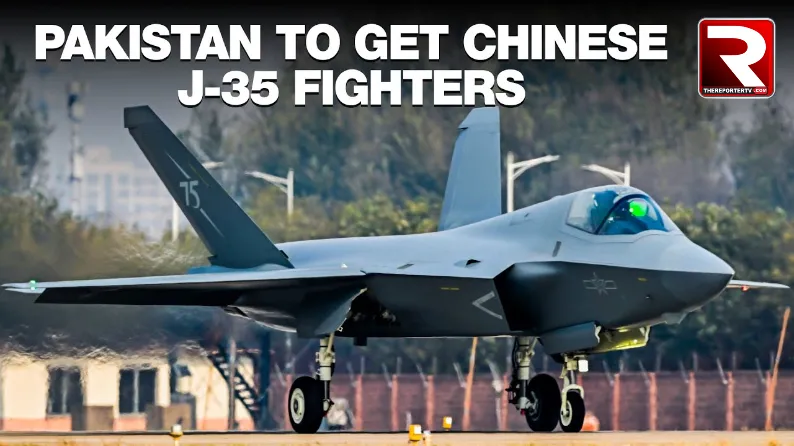As global dynamics shift and new military technologies emerge, India is facing a new set of challenges in its pursuit of maintaining air superiority. Pakistan is set to acquire China’s J-35 stealth fighter, a fifth-generation aircraft equipped with advanced capabilities that could alter the regional balance of power.
The acquisition of the J-35 by Pakistan is expected to significantly impact India’s longstanding dominance in the skies, especially with the aircraft’s state-of-the-art stealth technology, which enables it to evade radar detection and carry out surprise operations. The introduction of these advanced aircraft into Pakistan’s aerial fleet is raising national security concerns for India.
In an interview with ETV Bharat, Major General (retd.) PK Sehgal shared his insights, explaining that the acquisition of 40 J-35 stealth fighters by Pakistan could raise alarms within India. However, he cautioned that this development may not drastically shift the air power dynamics in favor of Pakistan. Reflecting on the 1965 war, where despite operating outdated aircraft like the Canberras, Vampires, and Mishtiyas, India emerged victorious against Pakistan’s more advanced Sabres and Super Sabres, Sehgal emphasized that morale, motivation, training, and leadership are crucial factors in warfare.
Nevertheless, Sehgal acknowledged that India’s air force needs to remain vigilant. The introduction of the J-35 could indeed become a pivotal factor in the evolving security situation.
Impact on the India-China-Pakistan Triangle
The defense expert noted that the acquisition of stealth aircraft by Pakistan could dramatically alter the dynamics of the India-China-Pakistan triangle. If hostilities were to break out on both fronts, Pakistan and China would be able to field 65 squadrons of advanced aircraft, while India would only have 32 squadrons available. With both neighboring nations introducing fifth-generation stealth aircraft, India’s air superiority could be significantly threatened.
To counter these developments, India must take proactive measures, according to Sehgal. One such strategy would involve investing in tens of thousands of drones to target and neutralize the air bases from which these advanced fighters operate. He pointed out that Pakistan’s relatively limited strategic depth compared to India and China could make it vulnerable to such a strategy.
Sehgal further explained that despite Pakistan’s attempts to enhance its air and naval capabilities with Chinese assistance, it is unlikely to create a substantial imbalance in the region. He emphasized that India’s larger size, greater resources, and significantly larger defense budget make it virtually impossible for Pakistan to alter the existing military balance in the subcontinent.
The J-35: A Game-Changer for Pakistan
The J-35, a twin-engine, all-weather, multi-role stealth fighter developed by China’s Shenyang Aircraft Corporation, has the potential to dramatically boost Pakistan’s aerial capabilities. Comparable to the American F-35, the J-35 is designed to be an air superiority fighter, capable of carrying out a variety of missions with enhanced stealth and radar-evading capabilities. Armed with advanced sensors and an array of air-to-air and air-to-surface weapons, the J-35 could pose a significant challenge to India’s air force.
Pakistan’s acquisition of the J-35 fits into its broader strategy to modernize its military and counter India’s advancements in aviation technology. The strategic partnership between Pakistan and China has provided Islamabad with access to sophisticated weaponry that would have otherwise been beyond its reach, considering the complex geopolitical landscape of South Asia.
India’s Response: Enhancing Air Defence Systems
As Pakistan strengthens its military with the J-35, India must enhance its air defense capabilities to neutralize the stealth advantage of these advanced fighters. One of the key measures India could take is to upgrade its air defense systems, such as the S-400, which India recently obtained from Russia. Additionally, bolstering local air defense systems like the Akash and Barak-8 would provide an additional layer of protection.
Sehgal stressed that increasing the number of these systems would allow India to detect and neutralize stealth fighters before they pose a significant threat. As modern warfare increasingly relies on space technology, India could also enhance its satellite and space surveillance capabilities to counter the risks posed by stealth aircraft. By utilizing space-based reconnaissance, India could monitor enemy aircraft even before they enter its airspace, allowing for timely preemptive actions.
As the security situation in South Asia becomes more complex, India’s air force must adapt to the emerging challenges posed by advanced technologies like the J-35. With the right investments in air defense systems, drones, and space-based reconnaissance, India can maintain its strategic advantage in the region and safeguard its national security.












